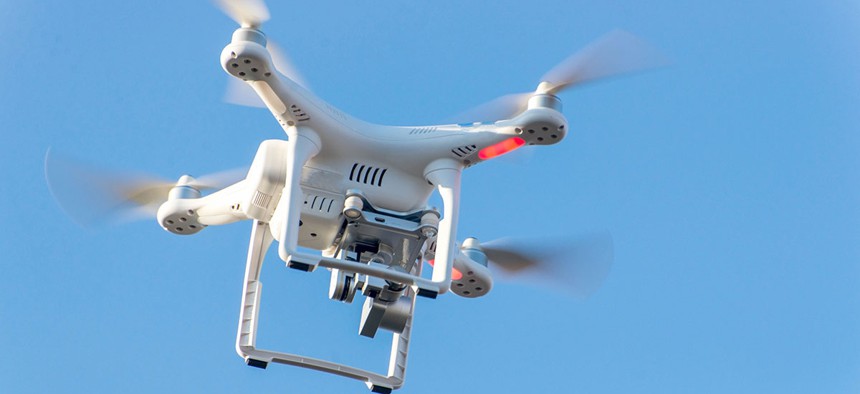I Could Kill You with a Consumer Drone

KAE CH/Shutterstock.com
As a former intelligence soldier who now sells drones for a living, I can tell you this problem is bigger than almost anyone realizes.
Right now, I’m holding a drone that can fly thousands of feet in air in less than 30 seconds, getting it to an altitude where no one could see it. My drone could be up in the air, ready to strike a target before you even had time to blink.
A range extender I’ve added to the antenna allows me to control it up to 7 miles away. Or I can click a button to activate a tracking device, ordering my drone to follow a vehicle or person, filming every movement in 4K high-definition video. If it ever loses its radio link to the controller, it can automatically return to its launch location. Except—this drone is not meant to come back. It is not meant to take nice photos of my vacation. It is meant to strike. A small mechanism allows it to carry and drop a 2.5-pound payload—potentially grenades, bombs, even poison.
Think that’s pretty high tech? Guess what—you can buy it at your local Apple store or Walmart.
As a former soldier in the U.S. Army with previous access to some of the most sophisticated and sensitive drone technology in our government’s arsenal, and as the current owner of a consumer drone business that sells tens of thousands of drones every year, I can tell you the U.S. government should be concerned. I know how consumers are modifying them to meet their needs, and I can tell you the problem is going to get bigger than anyone thinks, and fast.
In 2016, more than 2.5 million drones were sold in the U.S., more than twice as many as the previous year. That’s doesn’t even account for the millions of other drone sales worldwide. At one point, the multibillion-dollar Chinese manufacturer DJI was selling over 100,000 of the drone I described above every single month around the world. While great for businesses like mine, these types of devices can be dangerous in the wrong hands.
When most people look at drones readily available online, they have no idea what they can do. From little kids flying in their backyard to seniors getting these as holiday gifts, most people think of these incredibly technologically advanced devices as simply toys or fun flying cameras. The majority of them have no intention to use these to hurt anyone.
But as we all know, the majority is not what we care about, it’s the outliers. It’s the foreign governments that sponsor terrorism and the criminal organizations that might use this technology as an unconventional weapon, and even on U.S. soil. In my new memoir, "Drone Warrior," I explain the gap between government and consumer drone technology is getting narrower by the day; the government regulations designed to do something before it gets out of hand currently inadequate.
Meanwhile, on the military side, the Pentagon is still buying Boeing Scan Eagles at hundreds of thousands of dollars a pop when they can buy a similar capability for only a few thousand dollars at a local hobby shop. ISIS has clearly figured it out, but I worry our government is still behind in its understanding of just how far the consumer technology is advancing and makes me wonder why it hasn't done more to bring industry leaders who know consumer drones in to help.
It makes me wonder why the U.S. government and special ops tactical units are not purchasing more consumer drones for themselves to do what they do best: take the fight to the enemy.
I’ve seen both sides of the fight, and have to watch the nearly daily reports that cross my desk of how ISIS and other groups in the Middle East and Africa are modifying drones, destroying their targets with precision and then recording the aftermath for the world to see. They could even add thermal imaging and infrared cameras to the devices now for a night-time attack capability, and conduct simple tweaks to the flight controllers to ensure they are following pre-determined flight patterns that can’t be hacked. Of course, they don’t have anywhere near the same level of precision as U.S. forces, but with the current rate of the technology in this field, they simply don’t need it.
One more example, the Skywalker X8 fixed-wing aircraft has a range of 10 kilometers, can live stream a video feed of its target, and has a small compartment that can be packed with a small improvised explosive. Coupled with a few quick modifications of the internal GPS and flight controller to ensure it flies out of site and fast to the target, and it is a no-brainer as the drone strike capability of choice for ISIS.
The problem isn’t getting any better and the government needs help. According to late-2016 research from the company Intel Center, terrorist use of drones in combat zones was growing at a substantial rate. The cost of the technology is dropping dramatically. The government spends hundreds of millions on defense contracting companies to make military drones safer; now it’s time to spend money on the consumer side before it’s too late. Everyone should be concerned.
NEXT STORY: For Google, Everything Is a Popularity Contest





